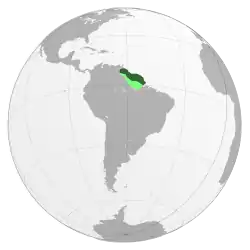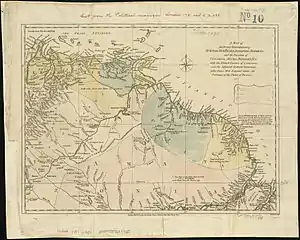Dutch colonisation of the Guianas
Dutch colonisation of the Guianas—the coastal region between the Orinoco and Amazon rivers in South America—began in the late 16th century. The Dutch originally claimed all of Guiana (also called De wilde kust, the "Wild Coast") but—following attempts to sell it first to Bavaria and then to Hanau and the loss of sections to Portugal, Britain, and France—the section actually settled and controlled by the Netherlands became known as Dutch Guiana (Dutch: Nederlands-Guiana).
Dutch colonies of the Guianas | |
|---|---|
 Flag | |
 Dutch controlled Guiana at its greatest extent in dark green; claimed but uncontrolled land shown in light green. | |
| Common languages | Dutch |
| Today part of | |
The colonies of Essequibo and Demerara were controlled by the Dutch West India Company, while Berbice and Surinam were controlled by the Society of Berbice and the Society of Suriname, respectively. Cayenne also came under brief periods of Dutch control. After the Napoleonic Wars in 1814, Britain gained control of the three colonies (Demerara, Berbice, and Essequibo) west of the Courantyne River, which became British Guiana and then modern Guyana. The remaining colony, Suriname (also called "Dutch Guiana"), remained under Dutch control until its independence in 1975.
History
Origin
.png.webp)
The first cartographic reference to the region was in a 1599 map, drawn by Flemish geographer Jodocus Hondius. Beginning in 1581, the colonies were settled by Dutch colonists, most of whom came from the province of Zeeland. Trading posts were established near various rivers, including the Pomeroon, Essequibo, Berbice, and Suriname rivers. Many small commercial establishments, mostly bartering posts, were founded by French, Dutch, and English colonists. Due to the effects of disease and attacks from natives, these colonies rarely lasted long.
Establishment
The Dutch West India Company was created in 1621, and given unsupervised control of the colonies in South America. The colony was administered by Abraham van Peere, a Dutch explorer who had founded the settlement of Berbice. After the Third Anglo-Dutch War, England ceded the colony of Suriname, in exchange for New Amsterdam.
Dutch Guiana was not a political entity, but, rather, a geographical indication. The colonies that formed along Dutch Guiana were, initially, controlled by several entities. Essequibo and Demerara were controlled by the Dutch West India Company, while Berbice and Suriname were controlled by the Society of Berbice and the Society of Suriname, respectively. Cayenne (French Guiana) was also briefly controlled by the Dutch between 1660 and 1664, and again between 1676 and 1677.
Dissolution
Under the Batavian Republic, much of Dutch Guiana was once again occupied by the British. After the Napoleonic Wars in 1814, Britain gained control of the three colonies (Demerara, Berbice, and Essequibo) west of the Courantyne River. These three colonies became British Guiana. After 1815, there were five Guianas, referred to by their dominant languages: Spanish Guayana (Venezuela), British Guiana, Dutch Guiana, French Guiana, and Portuguese Guiana (Brazil).[1]
The colony that remained was part of the Kingdom of the Netherlands until 1975, when it became independent as the Republic of Suriname.
Geography
Dutch Guiana covered the majority of the Guiana Shield, with its borders ranging from the Orinoco Delta in the northwest, the eastern banks of the Caroní River in the southwest, to the Marajó island of the Amazon River delta in the southeast.
Dutch Guiana or Suriname
Although the Dutch colony of Surinam has always been officially known as Surinam or Suriname, in both Dutch[2] and English,[3] the colony was often unofficially and semi-officially referred to as Dutch Guiana (Dutch: Nederlands Guiana) in the 19th and 20th century, in an analogy to British Guiana and French Guiana. Using this term for Suriname is problematic, however, as historically Suriname was only one of many Dutch colonies in the Guianas, others being Berbice, Essequibo, Demerara, and Pomeroon, which after being taken over by the United Kingdom in 1814, were united into British Guiana in 1831. Before 1814, the term Dutch Guiana did not describe a distinct political entity, but rather all colonies under Dutch sovereignty taken together.[4] While referring to post-1814 governors of Suriname as governors of Dutch Guiana seems harmless, it is problematic doing the same for the pre-1814 governors, as that would imply that they had jurisdiction over the other Dutch colonies in the Guianas, which they had not.
Citations
- Jacobs, Frank (2012-01-16). "The Loneliness of the Guyanas". Opinionator. Retrieved 2021-02-01.
- See for example this royal decree separating Suriname from Curaçao and Dependencies (1845).
- In treaties between the Netherlands and the United Kingdom, the colony is consistently referred to as the Colony of Surinam, e.g. Convention between Great Britain and the Netherlands, relative to the Emigration of Labourers from India to the Dutch Colony of Surinam, the Accession of the Dutch colonies of Curaçao and Surinam to the International Union for the Protection of Industrial Property.
- This is e.g. how Jan Jacob Hartsinck uses the term in his Beschryving van Guiana, of de wilde kust in Zuid-America (Hartsinck 1770, pp. 257).
References
- Hartsinck, J.J. (1770), Beschryving van Guiana, of de wilde kust in Zuid-America, Amsterdam: Gerrit TielenburgCS1 maint: ref=harv (link)
